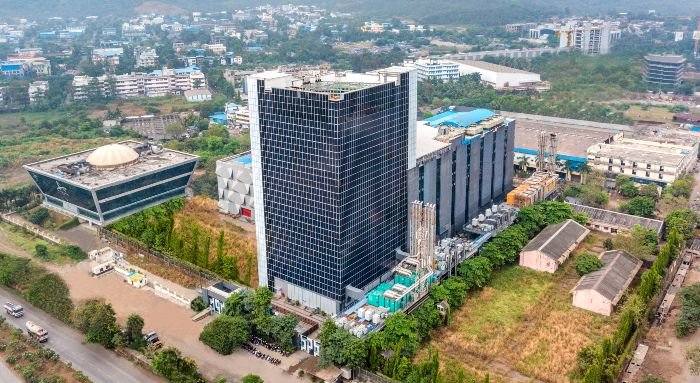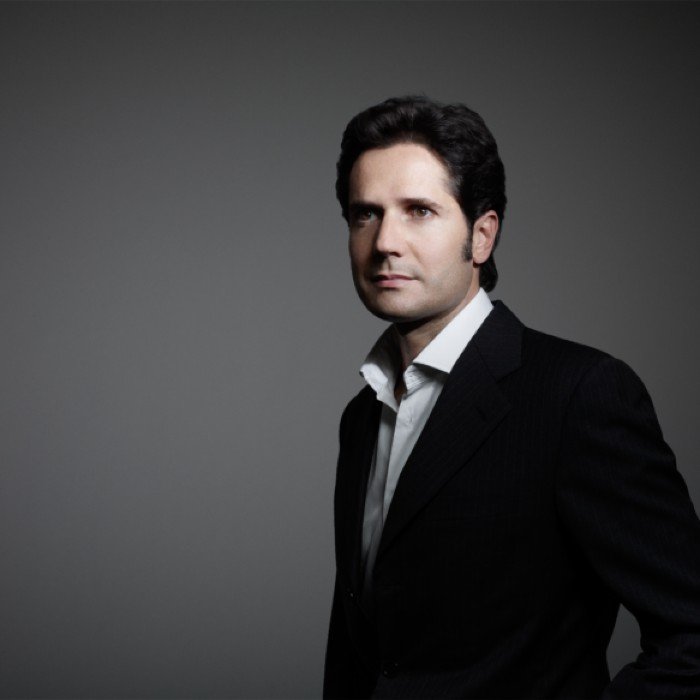A data centre serves as a vast storage facility for computer-related information. Within its confines, colossal racks house this data, each measuring approximately 600 mm in width, 1,200 mm in length, and 2,400 mm in height. These racks are arranged in orderly rows and aisles, sitting on a raised floor comprising removable 600 mm x 600 mm tiles, elevating them approximately 1 m above the standard floor level.
An intricate network of data cables runs beneath the raised flooring, connecting to the racks above. The stability of this elevated platform is ensured by a series of steel struts, positioned at 600 mm intervals in both directions, designed to bear the considerable weight of the racks.
The racks themselves stand tall at a height of 2.4 m, linked to an overhead network of electrical cable trays suspended from the ceiling. Additionally, data centres employ advanced climate control mechanisms facilitated by AC ducts suspended from the roof, ensuring automated temperature and humidity regulation.
A hallmark of data centres is their requirement for redundancy and uninterrupted power for smooth operations. For this reason, they boast dual electrical feeders, two sets of transformers, and parallel ducts for air conditioning. Moreover, they incorporate backup power solutions, such as dual generators and ample diesel reserves capable of sustaining operations for a week. This redundant infrastructure is complemented by Uninterruptible Power Supply (UPS) systems and robust battery backups, further fortifying its capacity for seamless functionality.
A data centre represents an intricately designed hub for storing and managing crucial digital information. It’s a meticulously structured environment that ensures data integrity and availability through meticulous planning, redundancy, and state-of-the-art infrastructure.
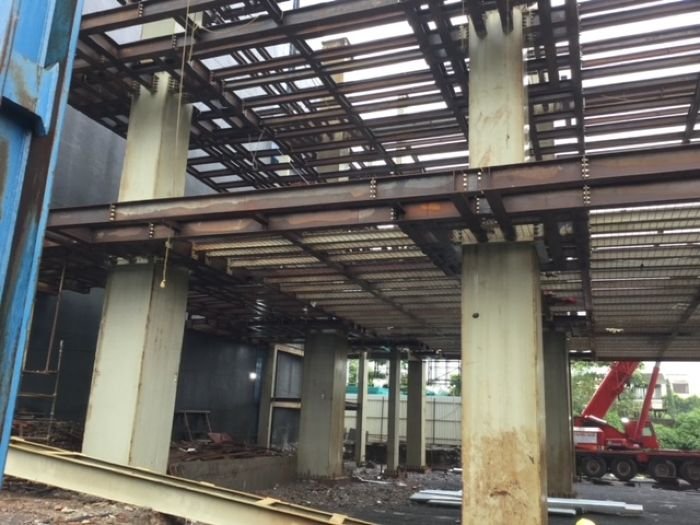
The state-of-the-art CtrlS Data Centre in Mumbai is an exceptional model of modern infrastructure, celebrated for its innovative strategies. Notably, it distinguishes itself by implementing a steel composite flat slab, underscoring its dedication to advanced and efficient infrastructure solutions. Collaborating closely, Sri Harsha Consulting Engineers and CtrlS delve into the intricate construction details of this remarkable structure.
Unparalleled innovation
The CtrlS data centre in Mumbai stands as India’s sole solar-covered rated 4 Hyperscale Data centre, setting a new standard in sustainable and efficient infrastructure. At the core of its operations lies uninterrupted service, boasting N+N UPS, utility power substation, and diesel generator redundancy. This robust setup ensures continuous support, vital for maintaining seamless operations in a data-centric landscape.
To guarantee optimal performance, the facility employs an N+1 cooling system redundancy, enhancing temperature management within the centre. The focus on reliability extends to its industry-best uptime SLA.
Furthermore, the centre employs numerous measures to ensure comprehensive monitoring and security measures. Integrated Building Management Systems (IBMS), CCTV, Fire Alarm Systems (FAS), Water Leak Detection (WLD), rodent prevention, Public Address (PA) systems, and Very Early Smoke Detection Apparatus (Vesda) collectively create an unparalleled surveillance infrastructure.
Additionally, the data centre facilitates neutral networking, enabling seamless interconnection between multiple telecommunication carriers. This open networking architecture not only enhances connectivity but also promotes collaboration and accessibility within the digital ecosystem.
In pursuit of optimal safety and environmental conditions, the facility incorporates Smoke Exhaust Systems, augmenting ventilation, along with a robust 4-pointer network path setup. This comprehensive approach to infrastructure design underscores CtrlS’s commitment to reliability, security, and sustainability.
Kirby completed the erection of the 12-storey steel structure within an impressive timeframe of 4 months. Concurrently, concrete works were completed for 6 floors, with brickwork in progress for an additional 4 floors. Notably, the entire building is enveloped by solar panels, emphasising its commitment to sustainable energy solutions. This remarkable achievement led the building to attain a prestigious platinum-rated LEED certification in the data centre category, underscoring its excellence in environmental performance and design.
Salient Features
|
Defying limits
Designing a structure without disrupting ongoing operations posed a significant challenge. The limited space available for construction materials added complexity to the endeavour. Ensuring continuity in operations necessitated precise alignment with existing floor levels. Complicating matters, the proximity of a fire sump and pump house to the current building mandated avoiding any disturbance to the existing facilities.
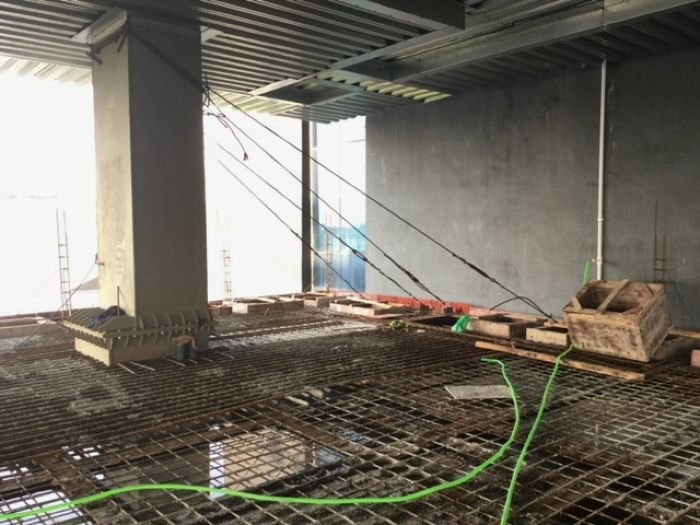
Addressing these challenges involved strategic measures, including positioning building columns 6.5 m away from the existing structure. To optimise space, cantilevers extending up to the building were incorporated into the design. Moreover, the project encountered geological obstacles with loose upper soil and rock strata emerging approximately 6-7 m below ground level. Consequently, foundations were placed on a solid rock surface, requiring an SBC of 300 tonnes per sq m for stability and support.
Design Parameters:
|
Forging the future
The initial requirement dictated a column grid of 12.5 m x 9.6 m, aligning with both architectural and functional specifications. While an RCC flat slab was initially considered, the logistical challenge of obtaining RMC in sufficient quantity and within the required timeframe posed a significant obstacle. Consequently, a shift towards a steel composite flat slab emerged as a viable solution, promising to address these challenges comprehensively. However, the primary hurdle was establishing composite action by providing deck sheets beneath the steel members.
The limited footprint of the building dictated its design for 12 floors, significantly impacting the available space for storing construction materials like shuttering and scaffolding. Addressing the pressing timeline constraints, the project necessitated an agile solution, thus steering the direction toward a steel structural framework.
The incorporation of steel proved pivotal in meeting the project’s timeline requirements. Evaluating the revenue earned during this period against the additional costs incurred for the steel structure indicated that choosing steel was the right decision. Particularly for projects where time is of the essence, steel structures offer an advantageous option, enabling the construction of multiple floors more efficiently.
To navigate this hurdle, Kirby, entrusted as the steel structural contractor, took charge. They orchestrated a demonstration at their factory to showcase the methodology of affixing the deck sheets beneath the steel structure. Utilising a unique tool resembling a gun, bolts were employed to shoot and fix nails, securing the deck sheets firmly to the steel members. This innovative approach facilitated the creation of a robust composite structure, effectively overcoming the challenges previously encountered with traditional construction methods.
Construction symphony
Kirby facilitated the project with a tower crane standing tall at 80 m. This towering equipment efficiently managed the complex structure, designed to reach 72 m, supported by a boom length of 50 m. Its remarkable load-carrying capacity at the tip, clocking in at 5 tonne, ensured the safe handling of heavy components. In addition, a mobile crane, adept at managing elements up to 24 m in height, complemented the tower crane, collectively streamlining the construction process.
The project’s cornerstone lay in the design and implementation of robust structural elements, notably the primary columns. Sized at a formidable 1,500 mm x 1,500 mm and filled with concrete, these columns underwent a meticulous process. The reinforcement cages, crucial for structural stability, were meticulously crafted and supplied by the civil contractor at Kirby’s factory. These cages, secured within the columns using tack welding, underwent rigorous quality checks before being transported to the site, ensuring the foundational strength of the structure.
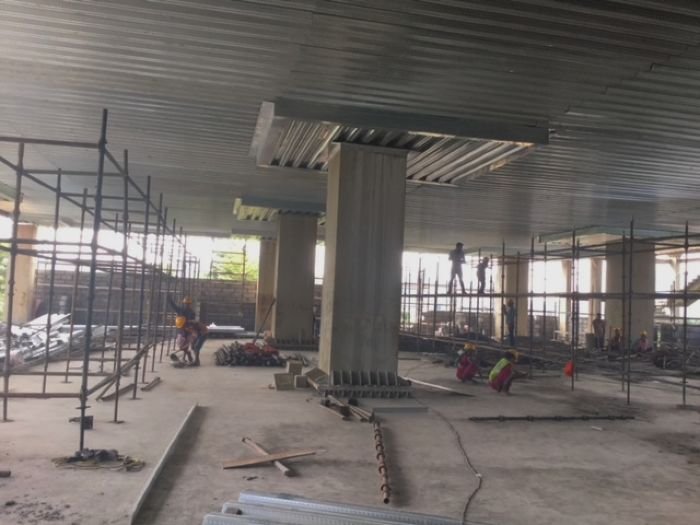
Another pivotal aspect of the construction involved the fabrication and installation of steel beams, crucial components shaping the flat slab structure. The flat slab’s capital portion featured steel beams with dimensions of I-web 400 mm x 10 mm thick + 2 FLG 250 mm x 12 mm thick, cleverly divided into halves for ease of transportation and installation. These beams were skillfully affixed to the columns using pre-provided nuts & bolts, ensuring a secure and robust connection.
Similarly, the flat slab portion consisted of meticulously crafted steel beams, sized at I-web 200mm x 8mm thick + 2 FLG 200mm x 10mm thick. These beams were manufactured at the factory, transported, and meticulously installed on-site using nuts & bolts, ensuring precision and structural integrity at every step.
Following the strategic placement of all requisite steel beams for the composite flat slab, an intricate process of reinforcing the structure ensued. Reinforcement cages were welded both at the bottom and top of the steel members, enhancing the structural solidity and ensuring compliance with rigorous safety standards.
The composite flat slab boasted final dimensions of 494 mm for the capital and 294 mm for the flat portion, resting atop the deck sheet (1 mm thick with a 52 mm pitch). Additionally, the 6.5 m cantilever portions featured tendons, strategically fitted to raise the edge by 75 mm, providing upward camber and effectively controlling deflection.
To manage concrete pouring, a prudent strategy involving half-depth concrete filling on the initial day was adopted. This method allowed the concrete to set as shuttering for subsequent pours, safeguarding the deck sheet from potential failure due to the weight of wet concrete. This approach ensured not just structural integrity but also operational efficiency throughout the construction process.
At CtrlS Mumbai, the culmination of groundbreaking innovation and design emerges as a testament to the future of data centres. Beyond its steel-clad infrastructure lies a beacon of technological advancement and sustainability. As this pioneering facility continues to push boundaries, it stands as a symbol of resilience, reliability, and the relentless pursuit of excellence in the ever-evolving realm of digital infrastructure. With each beam and panel, CtrlS Mumbai cements its legacy as a trailblazer.




